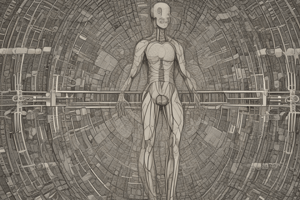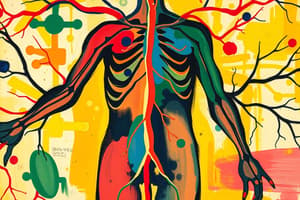Podcast
Questions and Answers
What type of muscle is primarily affected by the somatic motor pathway?
What type of muscle is primarily affected by the somatic motor pathway?
- Skeletal muscle (correct)
- Smooth muscle
- Adipose tissue
- Cardiac muscle
What is the primary neurotransmitter used in the somatic motor pathway?
What is the primary neurotransmitter used in the somatic motor pathway?
- Acetylcholine (correct)
- Serotonin
- Dopamine
- Norepinephrine
How does the somatic motor system primarily cause muscle contraction?
How does the somatic motor system primarily cause muscle contraction?
- Inhibiting the muscle fibers
- Using multiple neurons in sequence
- By increasing blood flow to the muscles
- Activating nicotinic ACh receptors (correct)
What distinguishes the somatic motor pathways from the autonomic pathways?
What distinguishes the somatic motor pathways from the autonomic pathways?
Where is the cell body of a somatic motor neuron primarily located?
Where is the cell body of a somatic motor neuron primarily located?
What characterizes the neuromuscular junction?
What characterizes the neuromuscular junction?
What occurs when somatic motor neurons are inhibited?
What occurs when somatic motor neurons are inhibited?
Which receptor is involved at the neuromuscular junction for somatic motor control?
Which receptor is involved at the neuromuscular junction for somatic motor control?
What occurs during a muscle twitch?
What occurs during a muscle twitch?
Which metabolic pathway produces lactate and does not require oxygen?
Which metabolic pathway produces lactate and does not require oxygen?
What distinguishes cardiac muscle fibers from skeletal muscle fibers?
What distinguishes cardiac muscle fibers from skeletal muscle fibers?
Which of the following statements about smooth muscle fibers is true?
Which of the following statements about smooth muscle fibers is true?
What is the primary function of the elastic elements in muscle contraction?
What is the primary function of the elastic elements in muscle contraction?
What triggers the opening of voltage-gated Ca2+ channels at the axon terminal?
What triggers the opening of voltage-gated Ca2+ channels at the axon terminal?
What effect does ACh have when it binds to the nicotinic cholinergic receptor?
What effect does ACh have when it binds to the nicotinic cholinergic receptor?
What causes the fusion of synaptic vesicles with the presynaptic membrane?
What causes the fusion of synaptic vesicles with the presynaptic membrane?
What happens to acetylcholine (ACh) after it is released into the synaptic cleft?
What happens to acetylcholine (ACh) after it is released into the synaptic cleft?
What is the primary ionic movement when the nicotinic receptor is activated?
What is the primary ionic movement when the nicotinic receptor is activated?
Which component of the synaptic junction helps degrade ACh to terminate its action?
Which component of the synaptic junction helps degrade ACh to terminate its action?
The process by which the motor end plate is modified occurs as a result of which event?
The process by which the motor end plate is modified occurs as a result of which event?
What role does the Sarcoplasmic Ca2+-ATPase play during the relaxation phase?
What role does the Sarcoplasmic Ca2+-ATPase play during the relaxation phase?
Which of the following is NOT involved in the excitation-contraction coupling process?
Which of the following is NOT involved in the excitation-contraction coupling process?
What is the role of the synaptic cleft in the neuromuscular junction?
What is the role of the synaptic cleft in the neuromuscular junction?
What triggers the opening of the Ryanodine receptor-channel?
What triggers the opening of the Ryanodine receptor-channel?
Which ion primarily contributes to the depolarization of the muscle fiber when ACh binds to its receptors?
Which ion primarily contributes to the depolarization of the muscle fiber when ACh binds to its receptors?
What is the primary function of the dihydropyridine (DHP) calcium channel during muscle contraction?
What is the primary function of the dihydropyridine (DHP) calcium channel during muscle contraction?
Why is the influx of sodium ions (Na+) significant in muscle fiber activity?
Why is the influx of sodium ions (Na+) significant in muscle fiber activity?
During relaxation, which structure is primarily responsible for the removal of calcium ions?
During relaxation, which structure is primarily responsible for the removal of calcium ions?
Which of the following best describes the relaxation phase of muscle contraction?
Which of the following best describes the relaxation phase of muscle contraction?
What happens to calcium ions during the relaxation phase?
What happens to calcium ions during the relaxation phase?
Which of the following is correct about the ryanodine receptor-channel in the context of muscle relaxation?
Which of the following is correct about the ryanodine receptor-channel in the context of muscle relaxation?
What is the relationship between ATP and calcium ions in the relaxation phase?
What is the relationship between ATP and calcium ions in the relaxation phase?
What role does the DHP receptor play in excitation-contraction coupling?
What role does the DHP receptor play in excitation-contraction coupling?
What triggers the release of Ca2+ from the sarcoplasmic reticulum?
What triggers the release of Ca2+ from the sarcoplasmic reticulum?
In the process of excitation-contraction coupling, what happens to the actin filament?
In the process of excitation-contraction coupling, what happens to the actin filament?
Which structures are involved in the release of calcium ions during muscle contraction?
Which structures are involved in the release of calcium ions during muscle contraction?
What is the function of troponin in muscle contraction?
What is the function of troponin in muscle contraction?
What ultimately allows myosin heads to execute the power stroke?
What ultimately allows myosin heads to execute the power stroke?
During excitation-contraction coupling, where does Ca2+ move after being released?
During excitation-contraction coupling, where does Ca2+ move after being released?
What is the consequence of calcium binding to troponin on the myofilaments?
What is the consequence of calcium binding to troponin on the myofilaments?
Which of the following accurately describes the first step in excitation-contraction coupling?
Which of the following accurately describes the first step in excitation-contraction coupling?
What is the end result of excitation-contraction coupling?
What is the end result of excitation-contraction coupling?
Flashcards are hidden until you start studying
Study Notes
Autonomic & Somatic Motor Control
- The somatic motor division primarily operates under voluntary control.
- Somatic pathways are exclusively excitatory; autonomic pathways can be excitatory or inhibitory.
- Somatic motor neurons originate from the ventral horn of the spinal cord or the brain, with their axons myelinated.
- Neuromuscular junction is the synapse between somatic motor neurons and skeletal muscle fibers, utilizing acetylcholine (ACh).
Neuromuscular Junction
- ACh is released into the synaptic cleft from presynaptic vesicles upon action potential arrival, facilitated by voltage-gated calcium (Ca2+) channels.
- ACh binds to nicotinic receptors on the postsynaptic membrane, causing depolarization of the muscle fiber through Na+ influx.
- Acetylcholinesterase (AChE) metabolizes ACh in the synaptic cleft, terminating the signal.
Excitation-Contraction Coupling
- Action potentials in T-tubules trigger conformational changes in dihydropyridine (DHP) receptors, which open ryanodine receptors (RyR) in the sarcoplasmic reticulum.
- Calcium is released into the cytoplasm, enabling binding of calcium to troponin, allowing interaction between actin and myosin for muscle contraction.
- Myosin heads execute a power stroke, pulling actin filaments toward the center of the sarcomere.
Relaxation Phase
- Sarcoplasmic Ca2+-ATPase pumps Ca2+ back into the sarcoplasmic reticulum to facilitate muscle relaxation.
- Calcium detaches from troponin, and tropomyosin re-covers the binding sites on actin.
- Elastic elements in the muscle return the fibers to their relaxed position after myosin heads release.
Muscle Contraction Dynamics
- A muscle twitch is defined as a singular contraction-relaxation cycle of muscle fibers.
Energy Metabolism in Muscles
- Three primary metabolic pathways for energy:
- Phosphocreatine breakdown: Provides a quick burst of energy with no oxygen requirement.
- Anaerobic glycolysis: Produces lactate and acid rapidly but releases limited energy.
- Aerobic respiration: Involves the citric acid cycle and electron transport chain, requiring oxygen and yielding significant energy.
Types of Muscle Tissue
- Skeletal Muscle: Large, multinucleated and striated; primary muscle responsible for voluntary movement.
- Cardiac Muscle: Smaller, branched, and striated with intercalated disks enabling coordinated contraction.
- Smooth Muscle: Small, non-striated, and involuntary; found in walls of hollow organs.
Studying That Suits You
Use AI to generate personalized quizzes and flashcards to suit your learning preferences.




